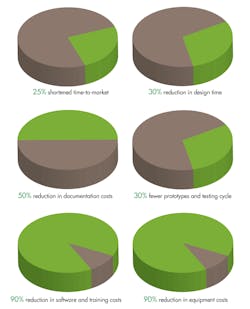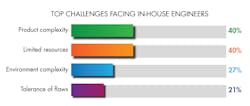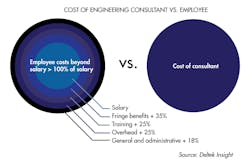What’s the Difference Between Consultants and In-House Engineers?
Download this article in PDF format.
In today’s competitive business environment, it’s more important than ever to bring high-quality, innovative products to market quickly and cost-effectively. For many organizations across a wide range of industries, the key to meeting this goal is a finely tuned product development process that includes powerful engineering simulation technology.
Simulation software is instrumental in reducing the time and costs associated with physical prototype testing of products for aerospace, automotive, biomedical, chemical equipment, oil and gas, power generation, construction, and manufacturing industries. As companies embrace simulation technology, they should consider what internal resources they have and which functions they may need to outsource to a professional engineering consultant to provide the best ROI.
The return-of-investment benefits for using engineering simulation services include a shorter time-to-market, reduced design time, less prototype iterations, testing, and reduced cost in software, training, and equipment.
Product simulation enables designers to perform structural, thermal, electromagnetic, fatigue, and fluid analyses to get deeper insight into performance and evaluate countless design iterations. The capabilities to compare alternatives, perform “what-if” studies with various parameters, and correct problems early in development all contribute to a better, higher-performing product while reducing costs and time to market.
In particular, engineers are making use of three important techniques critical to product development. Finite element analysis (FEA) is used to determine a variety of design attributes including structural stress, deflections, fatigue life, vibration, thermal distribution, and electromagnetic fields. Likewise, computational fluid dynamics (CFD) is used in studying flow, turbulence, pressure distributions, and other aspects of the interaction of liquids and gases with structures. Finally, electromagnetics (EMAG) is used to study low- and high-frequency product designs, such as motors and antennas.
To get the most value out of these powerful tools, a process is needed to fully integrate simulation into the product development process, from the early concept phase through post-production. With a standardized process, you can more easily leverage simulation at all levels of product development, including components, sub-system, and system levels. This not only ensures you are using simulation software as cost-effectively as possible, but research shows that engineering teams using simulation at all levels are more likely to meet internal targets for quality and revenue (Aberdeen Group, 2010).
Despite this, however, the actual benefits achieved by some companies often are lower than what may be possible. This inability to tap into the full potential of simulation may be due to several reasons, including challenges with initial implementation of software, failure to stay abreast of the latest advancements and revisions, and inexperience with best practices.
So how do you ensure you are realizing the full potential of your simulation technology?
Inside vs Outside Resources
Companies are facing a shortage of resources and in-house expertise to solve the engineering problems appearing in the wake of complex innovations (Source: Aberdeen Group).
While many companies spend time researching which simulation software to use, few spend sufficient time answering a more fundamental question: After we buy software, will we need external consultants as well? When faced with the choice between hiring an outside consultant versus using in-house engineering resources, there are a number of important factors to consider.
As today’s highly engineered products become more complex, many companies lack the resources and expertise in-house to solve all the design engineering problems that may arise. In fact, 40 percent of respondents in a recent industry study across energy, transport, and industrial markets noted that their in-house engineers struggled with product complexity. Similar challenges mentioned include limited resources, a lack of tolerance for design flaws, and the growing complexity of operating environments. In short, many enterprises find that their in-house engineering team is too small or lacking the needed expertise to fully leverage their simulation software. Yet, hiring new engineering staff is a significant expense, involving personnel costs well beyond salary, not to mention the costs of software licensing fees for each engineer.
Moreover, although graphical user interfaces and intelligent prompting capabilities have made the software easier to use, new users still must take time to learn new capabilities when they’re first implementing simulation tools. Later, with simulation technology changing so rapidly, companies may find it difficult to stay abreast of the latest advancements made after they implemented their software, such as multiphysics and other computational disciplines.
Unfortunately, underutilizing simulation software is commonplace, with some companies often two or three revisions behind the latest release. And too often, simulation is not as fully integrated into the organization and product development process as it should be, resulting in significant delays as separate engineering departments and central analysis groups throw projects “over the wall” to each other.
These challenges are compounded when companies find they need additional support from engineers with battle-hardened knowledge of their industry. An external engineering firm can take a company beyond the initial training to find insights and workflows that will maximize the software’s effectiveness. Likewise, if related software from other vendors is not supported, engineering teams often must deal with multiple suppliers to find support, piecing together disparate information in an effort to solve real-world problems.
Engineering Expertise for Hire
Accounting for hidden costs per employee and the added opportunity costs such as level of expertise and time to project completion is critical when deciding between the cost of an in-house employee and a consultant.
Understanding the many costs and benefits of engineering simulation is key to making informed management decisions about technology implementation and maintenance to best meet a company’s needs as they evolve over time. A balanced evaluation enables managers to accurately assess the business value of the technology, appropriate funding of simulation efforts, and expected levels of return on investment (ROI). Total costs in their entirety should be estimated along with the savings and revenue growth potential from the technology. For companies lacking time, resources, or in-house capabilities, outsourcing to an external engineering consultant is often the best option for engineering simulation projects, particularly when meeting tight product development deadlines.
Many engineering consultants are closely familiar with simulation, but it’s important to select a full-service engineering solutions provider committed to understanding the overall scope of the problems and to offering practical industry advice as well as support. A full-service engineering solutions provider offers the resources and real-world industrial experience needed for turnkey CFD, FEA, and EMAG simulation projects, as well as additional training, mentoring, and related services to support your in-house engineers and grow the expertise of your staff.
Hiring an engineering consulting firm with a full range of support services enables companies to fully leverage simulation techniques in a comprehensive, integrated approach to achieve real business value. As a result, these companies realize quantifiable ROI benefits that include reduced design time, shorter time to market, fewer prototypes and testing cycles, reduced liability, higher quality products, and lower documentation costs.
Rick James, Dr. Eng is President of SimuTech Group, Inc., the largest full-service provider of engineering simulation software from ANSYS in North America. The company provides training, mentoring, consulting, and testing services.
About the Author
Rick James
President
Rick James is President of SimuTech Group Inc., the largest full-service provider of engineering simulation software from ANSYS in North America. The company provides training, mentoring, consulting, and testing services




